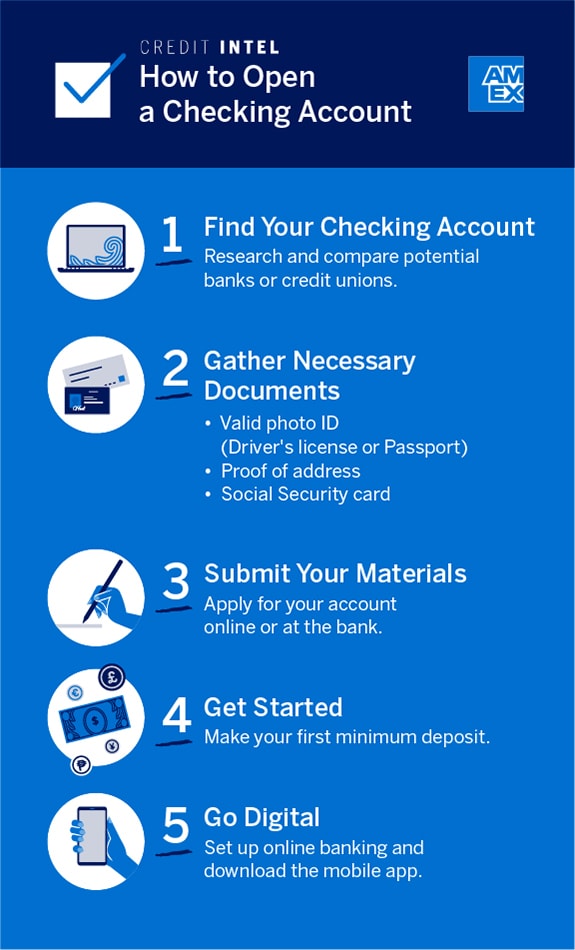How to Open a Checking Account
7 Min Read | Published: April 12, 2024

This article contains general information and is not intended to provide information that is specific to American Express products and services. Similar products and services offered by different companies will have different features and you should always read about product details before acquiring any financial product.
Learn how to open a checking account in this step-by-step guide, along with tips to help you manage your checking account effectively.
At-A-Glance
- A checking account allows you to deposit and withdraw money easily, facilitating convenient payments and purchases.
- To open a checking account, you may need photo identification, proof of residency, other documents, and potentially a minimum deposit.
- Consider making a budget and maintaining a balance that will cover at least 1-2 months’ worth of expenses.
Checking accounts are an important part of your financial health and can help to facilitate everyday transactions and purchases.
A checking account provides a safe place to deposit funds, which you can use for everyday expenses and bill payments. Many come with debit cards, online banking features, checks, and Automated Teller Machine (ATM) networks to help you access your checking account and the funds that you have available.
If you’re looking to open your first checking account, or just looking to open a new one, here is a guide that will guide you step-by-step through the process.
Five Steps to Open a Checking Account

While the process of opening a checking account may vary depending on the financial institution, opening a checking account is relatively straightforward:
- Select an Institution
Start by comparing institutions and their checking accounts. Compare features, fees, ATM availability, branch access, mobile/online banking access, and customer service. Find the institution offering an account that best suits your needs. - Gather Application Documents
Opening a checking account typically requires you to provide several pieces of information, so you may need some documents. These may include:- Photo Identification (ID) (driver’s license, state ID, or valid passport)
- Social Security card or ITIN documentation (such as a tax return with your ITIN)
- Proof of residency (utility bill, lease agreement, mortgage statement, etc.)
- Complete a Checking Account Application
Next, fill out the application. You’ll provide information like:- First and last name
- Date of birth
- Contact information (email, phone number, physical address)
- Financial information (income, other bank accounts)
- Employment status
Note that the information that you’ll need to provide could vary, depending on the financial institution.
You can apply for an account online or at one of the institution’s branches. If applying online, you may have to upload copies of your documents to complete the application. If applying in person, bring your documents with you.
- Review and Sign Account Documents
After applying, the bank will present you with account terms and conditions. Review these carefully and bring up any questions you have. If everything looks good, sign documents to finalize the account. Your new account should open shortly. - Deposit Funds
Once your new checking account is open, make your initial deposit. You can typically do this in a few ways:- Deposit cash
- Deposit a check from another account
- Transfer funds electronically from another account
- Set up direct deposit with your employer (they deposit your paychecks into your account)
Some accounts don’t require a minimum opening deposit. In this case, depositing funds immediately is optional. However, other checking accounts may require a minimum deposit within a set time frame after opening your account. Make sure to deposit at least the minimum amount before this date to keep your new account open.
Four Tips for Efficient Account Management
Here are some tips for managing your checking account once you open it:
- Make a Budget
Making a budget helps you track your income and expenses to try and keep a positive balance in your checking account and avoid overspending. Try to account for irregular expenses, such as going out to eat or unexpected costs.
Once you have a budget, you can check it against account transactions to stay on track and potentially find expenses to reduce. As a result, you could avoid overdraft fees and potentially begin saving money to move toward financial goals. - Set up Direct Deposit and Auto Transfers
Consider setting up direct deposit with your employer. This lets them send your paycheck directly to your checking account, saving time and reducing the risks of losing a physical check.
Furthermore, if you have a savings account, set up automated transfers from your checking account to stay on track with your savings goals.
- Maintain a Large Enough Balance
Keep a small amount of money in your checking account beyond what you need to cover bills and expenses. This can help you avoid overdraft fees if an unexpected expense occurs, such as an unplanned purchase or a one-time expense like a car repair.
It may be sensible to keep one to two months of expenses in your account to stay safe,1 but the amount you should save depends on your needs and comfort level. - Monitor Your Account Regularly
Check on your account balance and transactions regularly. This keeps you on top of your monthly spending habits and helps you catch unauthorized transactions early, minimizing potential damage from fraud.
Many banks and financial institutions offer mobile and online banking to make monitoring your account easy. Furthermore, many let you set up account alerts for low balances, large transactions, potentially fraudulent transactions, and similar concerns. Utilizing these tools could help mitigate accidental overdrafts or fraud.
Frequently Asked Questions
How much money you need to open a checking account depends on the institution. Some banks require a minimum opening deposit and a monthly minimum balance while others do not. Check for minimum deposit requirements with the institution before applying.
You can have more than one checking account at a time. However, some banks won’t allow you to open more than one checking account at the same institution while others will.
The Takeaway
Checking accounts are a key component of your personal financial health, helping to facilitate everyday transaction. Applying is straightforward, once you’ve chosen a bank, you’ll want to gather your documents, review the account terms, and then start the application process.
SHARE
Related Articles
What’s the Difference Between a Checking Account and Savings Account?
Checking and savings accounts offer different features and benefits. Checking accounts are for regular transactions, while savings accounts are best for saving.
What Is Online Banking and How Does It Work?
Online banking offers a great deal of convenience, allowing you to access your bank account or conduct transactions via your smartphone, tablet, or computer.
Types of Savings Accounts
Savings accounts are useful to put money away for the future. Compare the different types of savings accounts to help determine which is best for you.
The material made available for you on this website, Credit Intel, is for informational purposes only and intended for U.S. residents and is not intended to provide legal, tax or financial advice. If you have questions, please consult your own professional legal, tax and financial advisors.












